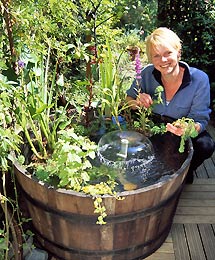





There are many reasons for adding a water feature to the garden. For most of us, however, it is the desire to grow aquatic plants or to keep fish. To do either, we need to construct a pond, and when we do that, we must create conditions that are conducive to the happy co-existence of all the inhabitants, be they plants or fish.
You cannot successfully integrate a specialized pond into the garden; it must be a balanced ecosystem. For example you can keep fish without plants, but filtration and oxygenation equipment becomes essential to keep them healthy.
Conversely, if you grow plants alone, insecticides will be necessary to control pests.
 Probably the most important factor that the newcomer to water gardening must appreciate is the interdependence of all life forms within a still water environment. With a stream, this is not as critical, although even there many elements still depend on each other.
Probably the most important factor that the newcomer to water gardening must appreciate is the interdependence of all life forms within a still water environment. With a stream, this is not as critical, although even there many elements still depend on each other.
A pool is a complete, self-contained environment, but influenced from outside, not only through additives to the water, but also its surroundings. As with most life, the sun is the powerhouse, and a pool denied full exposure will be doomed to a second-rate existence.
Water gardening is a facet of horticulture where both the science and art of gardening can be observed in their richest diversity. The scientific aspect lies in understanding something of the chemistry of the water and the life cycle and habits of the plants, fish and other aquatic creatures that live in it.
An artistic flair is required to ensure that the feature is not only placed sympathetically within the garden landscape, but also used to create other effects. These may not be purely visual, for with moving water sound is an important component. Certainly its value should be appreciated fully when a scheme is devised, whether it be the crashing fury of a mill race or the gentle trickle from a bamboo pipe. Apart from the rustling of living bamboo, there are few other natural sounds that the gardener can place and influence in quite the same manner.
Water should also be regarded as work of art and used as such. A flat placid area of water, in a formal garden, will reflect all about it. The pool will become a moody place when dark clouds cross the sky; it will exhibit stark beauty in winter when reflecting the naked branches of nearby trees; and it will be a cheery sparkling mirror when the sun shines. A properly maintained, clear formal pool can be an ever-changing picture that is like nothing else in the garden.
Such flexibility is also possible by using fountains. Regard these as sculptures in water, and take the opportunity to create a sequence of changing spray patterns. You can achieve this with a timer, which will fade one pattern into another, or you can run a particular water pattern for several weeks, then replace the fountain outlet with another to give a fresh look. Modern technology permits wonderful effects with fountains, among them ‘dancing’ jets of water to the accompaniment of music and coloured lights.
Such fantasy does create constraints upon the pool, and while many plants will tolerate such exuberance, sadly they do not include waterlilies. Provided such restrictions are appreciated from the outset, however, there need be little disappointment with the final planted scheme.
A waterfall is a more natural-looking addition to a water feature, which will provide greater flexibility in plant cultivation if positioned at one end of the pool, leaving a relatively undisturbed area at the other. Because it recreates a feature found in nature, it should appear to grow out of the garden, rather than sit on it. If a waterfall is planned at the time the pool is constructed, this should not be difficult to achieve.
This could also be said about the water garden as a whole, and the first principle when considering such a feature should be careful planning; not just for your immediate needs, but for the future as well. This is particularly applicable to a bog garden, for a true, fully-integrated and practical bog garden can be created with a pool liner if constructed at the same time as the pool. If added afterwards, however, it can often become isolated and a potential desert, the soil being separated completely from the surrounding ground and pool by an impermeable membrane.
Planning ahead and understanding what goes on in a pool, together with a knowledge of what is needed to make everything flourish, are the basic principles of successful water gardening. Unlike other aspects of gardening, there is much to learn before you start, but that process can be fun and will lead to a much greater enjoyment of your water garden itself. Once the practical aspects have been firmly grasped, the design elements can be addressed.
This site contains much information on not only these aspects but the influence that they have had upon the modern water garden, together with some of the key factors that you should observe. However, beauty is in the eye of the beholder, and no matter what the final result, provided it conforms with the basic principles set out here, it will be an undoubted success.
Copyright © www.100flowers.win Botanic Garden All Rights Reserved